In search of Mr. Cuddles | Route 1
Discover route 1 of the cuddle tour through Leuven. A city walk for little beeps. And grown-ups can come along. You can discover the route via Google Maps. You can also find the map at the bottom of this page.
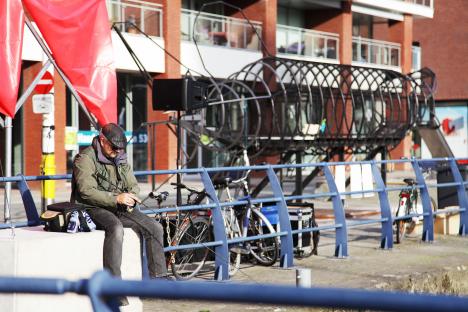
“Fish on dry land” play equipment
Local residents, children and young people from De Kettebende children’s activity programme and builders Menno Vandevelde and Tim Vanhentenryk joined forces to build this Fish on Dry Land or climb-grow-sport-fish during DUIK, a project that focuses on stories about the Leuvense Vaartkom (2016-2018). The fish is a living monument, even though he lies with his belly in the sand! Wriggle inside. Slide through his belly. And make him squirm with pleasure...
Park at Vaartkom + free electric shuttle bus to Leuven centre during weekends (more info)
Buggy Point Vaartkom
Vaartkom is one of two Buggy Points in Leuven. At the end of your walk, return your buggy here, or to the other Buggy Point under the Rector De Somerplein.
Vaartkom: de Kanaalgravers (statue)
The Leuvense Vaart was not always here. It was dug out by hand some 270 years ago by very strong men using shovels. The “De Kanaalgravers” statue is a reminder of these tough guys.
But it was Prince Charles of Lorraine who had the honour of digging out the very first shovel of earth. With a silver shovel no less. On 9 February 1750, the bells rang out. The cannons roared. And the city guards fired their muskets into the air when the prince solemnly deposited the first shovel of earth into a box.
That evening a fantastic party was organised on Grote Markt, including a theatre performance and an incredible firework display. The prince was invited to set off the fireworks. But it all went horribly wrong! The prince accidentally set his own wig on fire in the process and almost lost an eye!
The firework makers panicked and set off all the rockets at the same time. Some landed in the middle of the crowd. It was a disaster! And the Vaart filled with extinguishing water was far from ready...
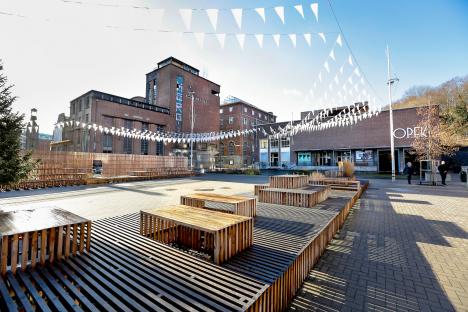
OPEK
Public means “for everyone”. Because people of all ages meet up in OPEK. In the Grand Café, for example. From the terrace you look out across the Vaartkom, a neighbourhood that is still changing, almost on a daily basis. Just look at all the cranes and building sites! Or in one of the theatres. In OPEK you can enjoy plays, music, workshops, festivals, training courses and much more.
Entrepot reminds us of what OPEK was once used for: as a customs warehouse or storage place. Take another look at the building’s façade. Such a high unloading bay or long concrete covered area is not a common sight. In the past, all kinds of goods were loaded and unloaded there. Railway wagons could roll in via the open space on the right.
Arts refers to the organisations that call OPEK home: Artforum & Urban Woorden, Wisper, Het Nieuwstedelijk, Y-Factor, Mooss, fabuleus and LUCA School of Arts. Each one focuses on art and culture.
However, the OPEK building itself is also a work of art: a listed monument by the architect Victor Broos. He designed the listed silo towers on the north bank too. As a tribute to the Leuven architect, in 2016 the city christened the square in front of OPEK “Victor Broosplein”. Not everyone thought it was a good idea. “Another man!”, they said. They thought “Douaneplein” (Customs square) was much better. Or “Marie Thumasplein”, after the first Belgian tinned food factory constructed on Leuvense Vaart in 1886. At least the factory where they canned fruit and vegetables was named after a woman!
Toilets/baby changing facilities
Hunting den Pieter Janssens Victor Broosplein
You can climb inside this artwork of a hunting den. You don’t even have to sit still. You won’t spot many wild animals here. Apart from a few wild children that is. And the occasional city pigeon! With this artwork, Leuven artist Pieter Janssens asks whether hunters really do love nature as much as they always claim they do. The artist doesn’t think so. Bang!
De Hoorn Brewery
In this listed building dating back to 1923, the very first Stella Artois was brewed in 1926: the characteristic Leuven beer. Inside you can still see the huge brewing tanks. Beer is no longer brewed here these days. Nevertheless, De Hoorn is still a lively venue for parties and work.
Toilets/baby changing facilities
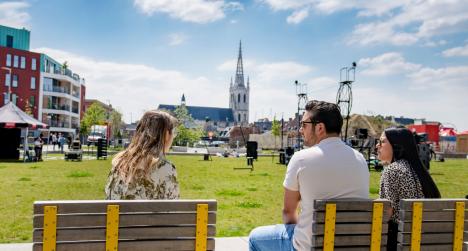
Sluispark
This brand new park in the trendy neighbourhood Vaartkom makes Leuven a little bit greener and bluer. It’s true! Because water plays the main role here, with the River Dyle that has been opened up, the long steps for sitting beside the river, the fish ladder especially for the fish and the water playground for genuine water babies.
Green Leaf
Leuven won this important European award in 2018, because the city aims to serve as a model for sustainable development. - Er, sustainable what now? - Well, Leuven wants to make sure that there is enough for everyone, forever. The city brings Leuven residents together to combat global warming. This artwork also invites everyone to sit and play together. Climb, hang, jump, in 1-2-3: GO!
Sluismolen
The Sluisstraat used to be home to the Sluismolen, one of the oldest windmills in Leuven! The windmill is no longer there. But you can still see the remains of the lock.
Try turning the small wheel. It doesn’t move much nowadays. This was often the case in the past too though! It was due to a couple of angry millers. According to a rule passed in 1332, boats had to be able to sail across the river twice a day without fail. The water had to be deep enough for them to do so: nine feet, that was also the law! To create this depth, the lock withheld the water twice a day; once in the morning and once in the evening. During this time, a bell rang in St Gertrude’s Abbey. But when the water stopped flowing, the windmill stopped turning. This meant that the millers couldn’t get on with their work and it made them angry. That’s why they shut down the lock on more than one occasion. And as a result, the millers and the skippers often ended up quarrelling here.
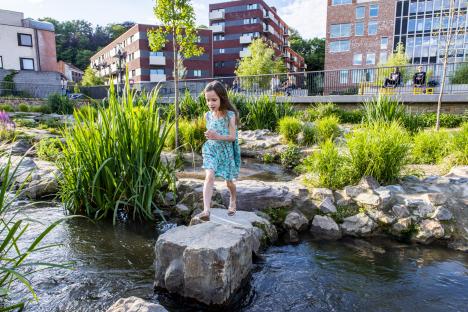
Vistrap
At this spot a weir blocks the water. It creates a difference in height of one and a half metres. Not a problem for fish that swim with the current. They will tumble down all by themselves. But the difference is too great for fish swimming against the current. Luckily they can manage it thanks to the fish ladder. It divides the height difference into small steps that any fish can quickly navigate!
Small Beguinage
Leuven has not just one, but two beguinages: small districts where beguines used to live until the 19th century.
Beguines were religious women. They didn’t marry or have any sweethearts. Just like sisters and nuns, they promised to be “pure” and “good”. But, in contrast to sisters and nuns, beguines did not promise it for ever and ever. They were also allowed to have possessions and their own home. Sisters and nuns promised to live a life of poverty as well.
This is the Small or Old Beguinage. It is smaller than the Great Beguinage, but not older! It just wasn’t as wealthy. The little houses deteriorated more quickly. That’s why this beguinage looked “old” sooner.
Katelijnehofje: old shoe factory
The well-hidden Katelijnehofje used to be the inner courtyard of a shoemaker’s premises. In the shop window there was always a shoe in a bowl of water. This gave shoemaker Guillaume Wanet his nickname: ‘the waterproof’.
Every Sunday morning, Wanet travelled to Brussels to deliver his shoes there and buy new raw materials. In the afternoon, he often went out on the town with friends and colleagues. Sometimes he returned home on Sunday evening, but he often stayed in the capital until Monday or Tuesday, to work day and night again until the following Sunday.
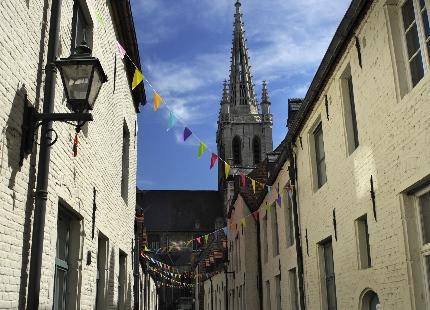
St Gertrude’s Church
The spire of St Gertrude’s Church is one of the 'seven wonders of Leuven'. Three of the seven wonders still exist. The tower is constructed exclusively from bluestone. All the pieces fit together like a jigsaw. Not a single nail was used to build it. And in the 15th century, people thought this was so incredible that they believed the spire had been built by “gnomes”!
In 1937, St Gertrude’s Church was declared a listed monument. But it was almost completely destroyed during WWII. The only part still standing tall was the wondrous gnome tower... As if by magic!
Work to rebuild the church began in 1950. In 1985, St Gertrude’s Abbey was also declared a listed monument.
Saint Gertrude’s Abbey
In the inner courtyard of St Gertrude’s Abbey, you can see façades that appear to be of some rather chic houses. A hundred years ago, the young ladies who studied at the university still lived behind these walls. But take another look. If you look closely at the chic façades you can make out debris from other, older houses: doorsteps, window frames, and different types of marble and stone, etc.
The abbey was built in the 12th century. But it was destroyed in WWI. Professor Armand Thiéry provided for a new west wing: the Thiéry wing. He constructed it out of debris from houses that had been bombarded to pieces. Nice and economical.
Vismarkt
In the past, the Vismarkt was situated beside an inner harbour. The water came up to here! Ships headed to this site carrying saltwater fish, salt and wool and left again loaded with grain, wood, wine and later also beer.
The water has retreated. But if you look carefully, you can still find some evidence of the watery past. The street between the Vismarkt and the Vaartstraat is called “Vissersstraat” (Fishers’ street). And look at the plaques above some of the houses on the south side: “de Vischbank” (the Fish Stall), “In de Dry Schepen” (In the Three Ships) and “De Drye Heringen” (The Three herrings). To the left of Busleidengang there is a house called “Sint-Andries”. This saint brought the fishermen good luck. Can you find the fish in the façade: two in the entrance and two pairs of fish a little lower down?
Of course, real fish were also sold on the Vismarkt.
Fishmongers had to follow strict rules. Fishermen from outside Leuven even more so than those from the inner city... A lot of lying and cheating went on to get around the rules and ended in a quarrel more than once.
Here are some of the rules:
- Only fishermen and butchers from Leuven could sell saltwater fish. On the fish stall. All week long.
- Fishermen from outside the city sold freshwater fish or “green fish”. In barrels. Only on Monday and Friday.
- A trading family was also only allowed to sell one type of fish. Either saltwater fish or freshwater fish.
- Saltwater fishmongers could also sell oysters. Only on the fish stall in the market.
- All fishermen were allowed to sell shrimp, crab, lobster, winkles, dried fish and salted cod. Throughout the city.
- Anyone could sell mussels. But this was only allowed on the Vismarkt before 11 a.m. It was also permitted elsewhere in the city after 11 a.m.
- Women were not allowed to be fishermen. They were only allowed to gut the fish and help out behind the fish stall, or help sell herring, salted cod, mussels and shrimp.

Mechelsestraat
Even more fishy remains! After all, the part of Mechelsestraat that is now full of shops used to be called Schipstraat.
The street was near the water. This made it an attractive place to live for a great many traders, craftsmen and those who ran establishments that served food and drink. It was also the dream location for inns and breweries. In around 1770, beer was brewed here in no fewer than 14 breweries! A hundred years later, there are just four left.
The Dyle terraces with Fiere Margriet
The inviting wooden terraces on the banks of the Dyle are the perfect place to pause or have a picnic. Stretch out beside Fiere Margriet, one of Leuven’s most famous statues, well, reclining statues that is (Willy Meysmans, 1982). There are several versions of this naked lady’s story. But it ends badly for her in every one. According to one version, the robbers kidnapped and murdered little Margriet! The villains dumped her body in the water. But fish carried Margriet’s body upstream as if by a miracle, while a strange light shone down on her. This is how the Duke of Brabant found out about the crime and pursued the villains.
Truth or fantasy? Who can say? But take another look at the statue... Is Margriet’s hair flowing with or against the current? And, uh... How can that be?
Margriet was also declared a saint. Since then she became the patron saint of hotels, restaurants and bars. She has her own chapel in Saint Peter’s Church.

